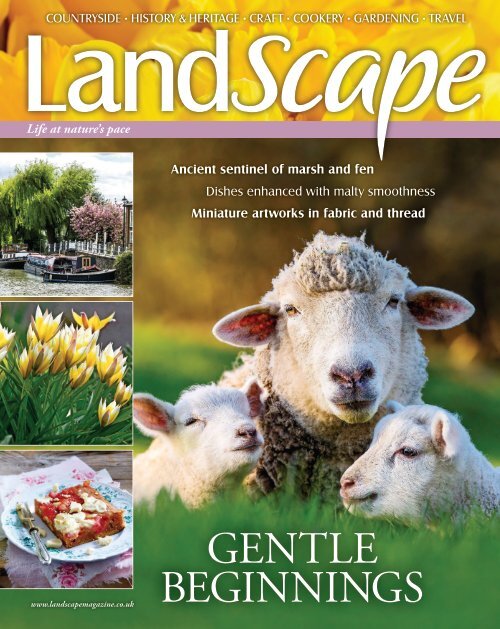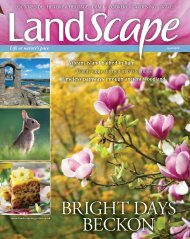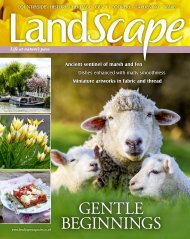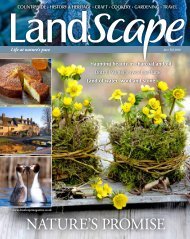You also want an ePaper? Increase the reach of your titles
YUMPU automatically turns print PDFs into web optimized ePapers that Google loves.
COUNTRYSIDE ▯ HISTORY & HERITAGE ▯ CRAFT ▯ COOKERY ▯ GARDENING ▯ TRAVEL<br />
Life at nature’s pace<br />
Ancient sentinel of marsh and fen<br />
Dishes enhanced with malty smoothness<br />
Miniature artworks in fabric and thread<br />
1<br />
www.landscapemagazine.co.uk<br />
GENTLE<br />
beginnings
Contents<br />
March 2018<br />
64<br />
92<br />
18<br />
In the garden<br />
In the kitchen<br />
Craft<br />
10 Species tulips reveal their treasure<br />
18 Tranquil plot comes to life<br />
26 The garden in March<br />
44 Woodland plants offer<br />
46 Growing miniature greens<br />
52 Fresh and tangy rhubarb<br />
60 Treat for teatime<br />
64 Dishes enhanced with silky stout<br />
70 Regional & Seasonal:<br />
The Cornish Seaweed Company<br />
30 Displays of heady hyacinths<br />
88 Cheery cushion knit<br />
100 Weaving twigs with colour<br />
4
112<br />
100 72 104<br />
Country matters<br />
History and heritage<br />
Regulars<br />
72 Fences brought to life<br />
104 A distinctive native breed<br />
38 Hillside home for ferns<br />
79 Cultivating a British brew<br />
92 Buttons of exquisite intricacy<br />
112 A tiny city’s Fenland triumph<br />
6 Readers’ letters<br />
8 Our <strong>LandScape</strong><br />
36 In the garden<br />
50 In the kitchen<br />
62 Subscription offer<br />
86 In the home<br />
122 UK events<br />
5
60<br />
• Photography: Steve Lee
teatime pleasure<br />
This firm fruity loaf is an ideal mid-afternoon<br />
indulgence, together with a cup of tea<br />
Speckled bread<br />
Makes 10 slices<br />
300ml boiling water<br />
2 teabags<br />
500g mixed dried fruit<br />
2 rounded tbsp light muscovado sugar<br />
4 tbsp fine-cut orange marmalade<br />
2 rounded tsp mixed spice<br />
250g white self-raising flour<br />
200g wholemeal self-raising flour<br />
butter, to serve<br />
Pour the boiling water over the teabags and leave to<br />
infuse for at least 5 mins. Pour the tea into a large<br />
mixing bowl. Add the fruit, stir well and leave overnight<br />
for the fruit to plump up and absorb the tea.<br />
Preheat the oven to 170°C/gas mark 3. Grease a<br />
900g loaf tin and put a strip of baking paper along the<br />
base so that it comes up over the ends.<br />
Using a wooden spoon, beat the sugar, 2 tbsp of<br />
the marmalade and the spice into the soaked fruit. Mix<br />
in the flours to make a firm, sticky dough. Add a little<br />
water if the mixture is too dry.<br />
Spoon into the tin and smooth the top. Bake for 1¼<br />
hrs until a skewer inserted into the centre comes out<br />
clean. If the top starts to brown too much, cover<br />
loosely with baking paper or foil.<br />
Take the loaf out of the oven and spread the<br />
remaining 2 tbsp of marmalade over the top so that it<br />
melts to make a sticky glaze. Leave to cool in the tin.<br />
To serve, cut into generous slices and spread with<br />
butter. The loaf will keep well for a week if wrapped in<br />
greaseproof paper or cling film and foil.<br />
Alternatives<br />
Replace some of the mixed dried fruit with dried<br />
cranberries, dried black cherries or dried blueberries.<br />
Instead of marmalade, use apricot jam or glaze the<br />
top with honey.<br />
Recipe from<br />
Cook it Slowly!<br />
Dairy Cookbook<br />
£8.75, available from<br />
www.dairydiary.co.uk<br />
61
Ely Cathedral rises from<br />
the water-ribboned fens<br />
like a ship in full sail.<br />
majestic city of<br />
marsh and FEN<br />
Commanding a vast landscape dominated by water,<br />
the tiny Isle of Ely has a rebellious past
In the home<br />
Seasonal decorative touches to bring the outdoors in<br />
Caring<br />
for cloths<br />
tradition<br />
woven in wool<br />
With their tough weave, cotton<br />
cleaning rags are economical and<br />
excellent for scrubbing and<br />
cleaning surfaces. However, they<br />
should be well cared for to<br />
prolong life and prevent the<br />
spread of germs. To clean, they<br />
are boiled for 15 mins before<br />
laundering as normal. Adding ½-1<br />
cup of white vinegar to the boil<br />
helps cut through grease. After<br />
each use, a thorough rinse before<br />
they are left to dry can prevent<br />
unpleasant smells, keeping the<br />
cloths fresh and hygienic.<br />
From a workshop in Hay-on-Wye, near the Brecon Beacons, Julie<br />
Leonard makes unique cushions, clothing and scarves, inspired by<br />
traditional Welsh textiles. Her tapestry design is based on an old<br />
Welsh pattern and double woven in pure new wool on a 1930s<br />
Dobcross loom. She makes each item by hand together with<br />
experienced local women, helping to create work in rural Wales. The<br />
bolster cushions are 12in (30cm) long and 5in (13cm) wide. They<br />
come in a variety of colour combinations which, once the short run<br />
sells out, are never repeated, ensuring their individual appeal.<br />
Bolster cushion from £48, thewelshgirl.com<br />
secret locations<br />
A worn table can be transformed into a unique piece of meaningful furniture with a<br />
square of map paper showing a favourite place. Areas of the table to be covered are<br />
sanded, then cleaned with a damp cloth to remove any dust. Applying a coat of primer<br />
aids adhesion. A square of map slightly larger than the table is cut out and glued<br />
carefully to the top, leaving 1in (2.5cm) spare at the edges. Bubbles and wrinkles are<br />
smoothed out before the edges are trimmed with a sandpaper block, using soft<br />
downward strokes to achieve an aged look. Finally, after the glue has dried, a layer of<br />
the dead flat type of varnish is applied. The legs can be removed with care, then sanded<br />
and primed. They can also be painted in a contrasting colour before being reattached.<br />
86
a surprising cup<br />
A row of different succulents arranged in unused soup and coffee mugs brings a touch of luscious greenery into the home.<br />
Succulents store water in their leaves, which are usually thick and fleshy. They tend to thrive in dry climates and do not like a<br />
humid atmosphere. They need water to survive, but can endure extended periods of drought, relying on the stored moisture<br />
and nutrients in their leaves. Care needs to be taken not to overwater. They respond best if their roots are soaked and left to<br />
dry out quickly. If their roots are sitting in water for too long, they will start to rot and die. Succulents need to be in a light<br />
place to thrive, but ideally not near a south-facing window as they can get burned if the light becomes too hot.<br />
longer life for<br />
picked daffodils<br />
Daffodils cut from the garden proclaim spring throughout the<br />
home, and their brightness is maintained with simple care.<br />
Daffodils release a sap-like substance that can be harmful to<br />
other flowers. If they are destined for a mixed arrangement,<br />
it is best to let them stand in cool, clean water on their own<br />
overnight first. They prefer shallow water, filling no more than<br />
half the vase and cutting stems on the diagonal will improve<br />
water absorption. Adding a teaspoon of sugar and a few drops<br />
of lemon juice helps keep the blooms in good condition.<br />
Photography: living4media; plainpicture; Loupe Images<br />
whirling colour<br />
Made from cotton washing line, the simplicity of these<br />
coasters highlights their design. A zigzag stitch in<br />
coloured thread binds the spiral, its sharp lines<br />
providing a striking contrast to the off-white curves.<br />
Crafted by Steph Bennett in rural Northamptonshire<br />
and available in four colours, they bring the brightness<br />
of spring to a morning cup.<br />
Cotton rope coasters £12 for four,<br />
www.designSix5.etsy.com<br />
87
woven wands<br />
Scarlett and Louis collect branches from the garden to<br />
practise simple weaves with colourful scraps of wool<br />
100
Spring prunings foraged<br />
from the garden can be used in a fun<br />
and engaging project. After<br />
collecting an armful of forked<br />
branches, Louis and Scarlett set about<br />
creating rainbow-coloured wands using<br />
leftover lengths of wool.<br />
Any damp branches are firstly left in a<br />
warm place indoors to dry out. Lichen can<br />
be cleaned off, but provides interesting<br />
texture and helps to keep the wool in place.<br />
The children are able to experiment<br />
with a variety of patterns and colours in<br />
their weaves. Afterwards, they can be used<br />
for play or to make a cheerful display in the<br />
home or among the flower beds.<br />
Scarlett and Louis<br />
gather up suitable<br />
branches from<br />
the lawn. These<br />
will provide the<br />
framework for the<br />
weaves.<br />
materials<br />
• Small, dry wishbone branches<br />
• Blunt needles<br />
• Leftover wool in a variety of<br />
colours<br />
• Scissors<br />
• Lengths of fabric cut into 1in<br />
(2.5cm) wide strips<br />
• A selection of large beads<br />
A secure base<br />
1. 2. 3.<br />
A dry branch is chosen and any<br />
knobbles or bits of twig snapped<br />
off. Rough bark can prevent the<br />
wool from slipping. One end of a<br />
small ball of wool is held securely<br />
at the base of the fork.<br />
Wool is then looped two to three times<br />
around the fork stem, covering the tail of<br />
wool to trap it firmly in place.<br />
The wool is looped around one prong and<br />
drawn across from underneath to the other<br />
prong. It is then wrapped around the second<br />
prong and pulled taut over the top across<br />
the gap. This is repeated so a tight loom is<br />
formed, with the wool alternately passing<br />
under and over the prongs. Once the wool<br />
reaches the end of the branch, it is tied off<br />
with a double knot.<br />
101
Our <strong>LandScape</strong><br />
The best of the season to inspire and admire<br />
secrets of the wildcat<br />
A dark-ringed bushy tail,<br />
tiger-like stripes and a muscular<br />
build identify the Scottish<br />
wildcat. Dr Christopher Clegg’s<br />
revealing book covers all there<br />
is to know about this impressive<br />
predator. Unique to Britain and<br />
now found only in Scotland, the<br />
wildcat’s history and habits,<br />
place in folklore and possible<br />
future are revealed.<br />
The Scottish Wildcat:<br />
Britain’s Most Endangered<br />
Mammal £20,<br />
www.merlinunwin.co.uk<br />
cornish celebration<br />
first light<br />
Hundreds of tiny white blossoms emerge in early spring on the<br />
bare, thorny branches of blackthorn. These prolific flowers are<br />
a common sight in hedgerows and along field edges, the spiky<br />
branches often being used as a natural cattle-proof barrier.<br />
As one of the earliest blossoms to appear, the multitudes of<br />
flowers provide an important source of pollen for foraging spring<br />
bees. Foliage arrives later and is itself a food source for many<br />
caterpillars, including those of the Brimstone moth and Brown<br />
Hairstreak butterfly. With its dark spiny wood and contrasting<br />
bright flowers, blackthorn has a traditional association with the<br />
cycles of life and death. Because of this, it is often used in the<br />
Celtic celebration of Imbolc, welcoming the beginning of spring.<br />
St Piran’s Day, or Gool Peran in Cornish, is the national day of Cornwall,<br />
celebrated on 5 March every year. The day is named after, and celebrates,<br />
St Piran, the patron saint of tin miners who is sometimes credited with<br />
discovering the metal. The Cornish flag, with its white cross on a black<br />
background, is said to represent the granite that rolled from his fire one<br />
night, oozing white tin. Though a definitive history is uncertain, it is believed<br />
that St Piran was born in Ireland in the 6th century. He was renowned for<br />
his miraculous deeds and legend tells that a group of jealous kings put a<br />
millstone around his neck and threw him into the sea. Instead of drowning,<br />
St Piran floated to shore at Perranporth, which still bears his name. There,<br />
he built an oratory to spread Christianity, his first disciples being a fox, a<br />
bear and a badger. Today, hundreds of people make a pilgrimage to<br />
Perranporth and the site of St Piran’s Oratory. Every year, the St Piran Play<br />
is held at Perran Sands, usually on the nearest Sunday to 5 March.<br />
8
a loving<br />
bond<br />
The relationship between a lamb and its mother is<br />
very close, and the first hours after birth are an<br />
important bonding time for both. The ewe will first<br />
lick and dry the newborn lamb and may ‘speak’ to it<br />
as she does so. During this time, the animals<br />
become familiar with each other’s scent and voice.<br />
The lamb’s first meal is colostrum, a milk which<br />
contains maternal antibodies and is rich in nutrients,<br />
helping to ensure the best start in life. Experienced<br />
mothers nudge newborns to the teat if they struggle<br />
to find it. As the lamb grows, it develops confidence<br />
and curiosity, venturing further afield to play and<br />
explore. If it wanders too far, for too long, the dam<br />
calls out. Mother and lamb recognise each other’s<br />
voice and will bleat anxiously until they are reunited<br />
and the bond restored.<br />
golden trumpets<br />
Daffodils cast in silver or 9-carat gold capture the arrival of<br />
spring. They are designed by Lizzie Kershaw, who takes her<br />
inspiration from the natural world, especially plants and<br />
flowers. She uses traditional gold-smithing techniques to<br />
saw, file and hammer the metal, recreating by hand the<br />
particular textures of the season’s emblematic flower.<br />
Daffodil earrings from £35, www.lizziekershaw.co.uk<br />
Photography: Alamy; Shutterstock; Richard Faulks; Nature Picture Library<br />
nature’s thermometer<br />
Covering the woodland floor with gleaming yellow, lesser celandine,<br />
Ficaria verna, is one of the first spring flowers to emerge after the<br />
dormancy of winter. Its warm colour is a celebration of the returning<br />
warmth and light. A perennial herb, lesser celandine’s glossy yellow<br />
petals radiate from a slightly more orange centre, surrounded by dark<br />
green, heart-shaped leaves. They tend to grow in abundance, rarely taller<br />
than 2in (5cm), and forming carpets of star-shaped flowers. The flower<br />
struck William Wordsworth so deeply that he wrote three poems about it.<br />
One, To the Small Celandine, ends with the joyful declaration: ‘Spring is<br />
coming. Thou are come!’<br />
9
Discover more<br />
with Landscape<br />
Click here to<br />
order your copy<br />
directly to your door<br />
today, with free<br />
UK delivery<br />
GORGEOUS GARDENING, INSPIRATIONAL COOKERY,<br />
WONDERFUL HERITAGE, EXQUISITE CRAFT AND MUCH MORE<br />
Live life at nature’s pace
















